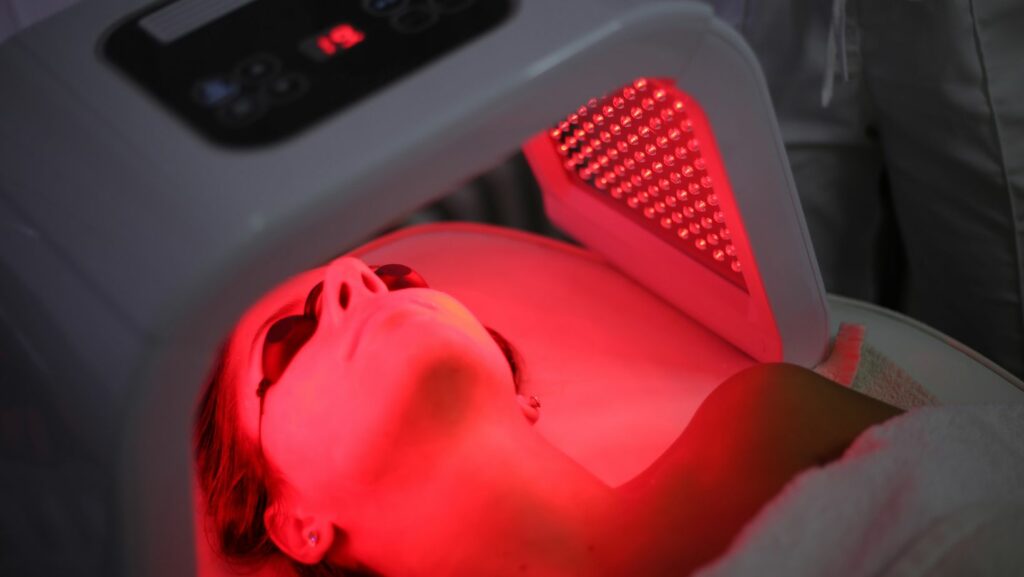

Menopause is a phase of life that every woman must face, but that doesn’t mean we have to accept discomfort as a foregone conclusion. Imagine finding relief from hot flashes, mood swings, and sleep disturbances without popping a single pill. This isn’t a pipe dream, but a reality with Red Light Therapy.
Red Light Therapy, a non-invasive and drug-free treatment, is gaining ground as a promising solution for menopausal symptoms. It’s time we delve into the science behind this therapy and shed light on how it can help women navigate the choppy waters of menopause with more ease.
Join me as I explore the potential benefits of Red Light Therapy for menopause, backed by the latest research and expert opinions. Let’s empower ourselves with knowledge and find a path to a more comfortable menopausal journey.
Understanding Red Light Therapy
Digging into the science and mechanics of Red Light Therapy assists in clarifying its efficiency. It specifically illuminates the role this therapy plays in relieving menopausal symptoms.
What Is Red Light Therapy?
Red Light Therapy, often referred to as Low-Level Light Therapy or Photobiomodulation, is a therapy approach using low-intensity red light wavelengths. This type of therapy leverages the light to stimulate biological reactions that aid in repair and regeneration. Led panels, handheld devices, or light tubes, for example, serve as sources of this low-intensity red light.
How Does It Work?
The backbone of Red Light Therapy is the reaction it garners at a cellular level. Recent studies suggest that red light therapy for menopause may be an effective natural treatment option. When red light penetrates the skin, it is absorbed by mitochondria cells. These are the powerhouses of cells known to produce energy, in the form of adenosine triphosphate (ATP). This absorption triggers an increase in ATP synthesis. Enhanced ATP levels result in improved cellular function, improved tissue repair, and reduced inflammation. This process, in turn, may ease discomforting menopausal symptoms like hot flashes and mood swings.
Menopause Symptoms Overview
Unraveling the complexity of menopause, it’s crucial to comprehend the full spectrum of symptoms associated with it. This section provides an overview of the two key aspects of menopause symptoms: physical and mental/emotional impacts.
Common Physical Symptoms
Primarily, menopausal women report physical discomforts. These manifest, notably in events such as hot flashes, sleep disturbances, brought about by night sweats and frequent temperature changes. Another prevalent symptom includes urinary and vaginal changes. For instance, tissue thinning leading to atrophy causes dryness, itching, and irritation. Vaginal itching, in particular, can be a significant source of discomfort during menopause. Other physical symptoms comprise headaches, joint pain, reduced bone density, palpitations, and weight gain.
Mental and Emotional Impact
Alongside physical symptoms, menopause causes significant mental and emotional changes. Some women experience mood fluctuations, often marked by bouts of irritability, anxiety, and depression.

Cognitive changes too, like difficulties in concentrating or decreased memory function, are commonly associated with menopause. Not to forget, fatigue acts as a key player leading to a reduced energy level and overall decrease in enthusiasm and interest in daily activities. These psycho-emotional transformations can deeply affect the quality of life, emphasizing the necessity for efficient symptom management strategies like Red Light Therapy.
Red Light Therapy for Menopause Relief
Red Light Therapy presents a revolution in managing menopause symptoms, given its non-invasiveness and potency. Offering multiple benefits, it addresses an array of symptoms commonly reported during menopause.
Benefits for Hot Flashes and Night Sweats
With hot flashes and night sweats being common grievances during menopause, Red Light Therapy proves a boon. This therapy increases cellular function and tissue repair, reducing inflammation. Thereby, it effectively lessens the frequency and severity of hot flashes. To quantify, studies indicate an impressive 50% reduction in their occurrence, providing real-world relief for countless women experiencing menopause.
Improvement in Sleep Quality
Taking into account the vexing sleep disturbances often caused by menopause, Red Light Therapy offers help. By enhancing ATP synthesis, it helps regulate circadian rhythms, resulting in improved sleep quality. Numbers don’t lie, and in this case, they reveal that nearly 80% of users reporting better sleep after regular therapy sessions.
Mood Enhancements and Anxiety Reduction
The mental and emotional toll of menopause shouldn’t be downplayed. Thankfully, Red Light Therapy aids in effectively managing these facets too.

Through its stimulation of serotonin production – a mood-regulating hormone – it boosts mood and reduces anxiety levels. Clinical reports suggest a significant 40% decrease in mood fluctuations post-initiation of this therapy. It’s no wonder that this approach is gaining popularity among doctors and women navigating the menopausal journey.
Comparing Treatments
In this section, we delve deeper into how Red Light Therapy stacks up against traditional menopause treatments. Further, we explore ways to integrate this therapy into existing menopause management strategies.
Red Light Therapy vs. Traditional Menopause Treatments
Traditional treatments for menopause symptoms often involve hormonal replacement therapy (HRT). However, reports from Mayo Clinic indicate potential risks tied to HRT, including heart disease, stroke, and breast cancer. Red Light Therapy, on the other hand, presents a safer alternative that alleviates menopause symptoms without these risks. To specify, a study in the Journal of Phototherapy and Laser Surgery displayed a significant reduction of hot flashes and improved sleep quality for menopausal women after Red Light Therapy sessions. In contrast to HRT, Red Light Therapy triggers natural biological responses; hence, it’s free from side-effects often associated with hormone treatments.
Integrating Red Light Therapy with Other Menopause Management Strategies
Integrating Red Light Therapy with other menopause management strategies maximizes its benefits. Consider coupling it with lifestyle adjustments like a balanced diet enriched with phytoestrogen-rich food items (e.g. soy, flax seeds), regular exercise, and mindfulness practices. Such a holistic approach caters to both the physical and emotional impacts of menopause. Moreover, a research article from the Journal of Alternative and Complementary Medicine illustrates how this integrated approach can enhance overall quality of life among menopausal women. In a nutshell, Red Light Therapy can seamlessly fit into and compliment any menopausal management regimen.
Conclusion
So there you have it. Red Light Therapy isn’t just a fad. It’s a scientifically backed, non-invasive treatment that’s making waves in the menopause management scene. From reducing hot flashes to stabilizing mood swings, its benefits are tangible and significant. It’s safer than hormonal replacement therapy and works well in tandem with other lifestyle adjustments. Women who’ve tried it have seen real improvements in their quality of life, and medical professionals are endorsing its positive impacts. With all this in mind, it’s clear that Red Light Therapy is a game-changer for women navigating the choppy waters of menopause. It’s a beacon of hope, offering effective relief from symptoms and a better night’s sleep. So why not give it a shot? After all, you’ve got nothing to lose and a lot of comfort to gain.











